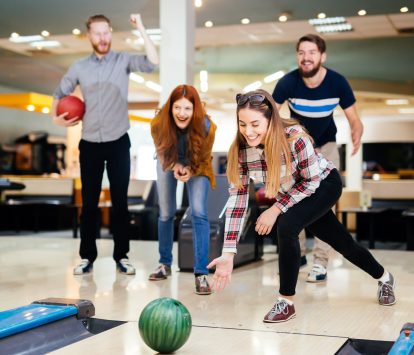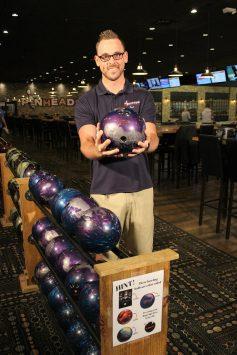Could Lower Oil Volume Address Bowling's Worsening Performance Gap?

BY DENNIS BERGENDORF
 They're having a great time, but are they learning how to hook the ball and get strikes? Will they be back?
They're having a great time, but are they learning how to hook the ball and get strikes? Will they be back?
Of all the individual participation sports — bowling, golf, tennis in particular — the one with the widest gap between novice and expert is bowling. There is no need even bother using the word “arguably.”
In golf, you can borrow or rent a set of clubs, but you play the same ball as the big boys and girls and on the same course (if you’ve got the bucks and can handle a six-month wait, TPC Sawgrass can be the site of your 50-over-par misadventure). In tennis, you can buy a serviceable racquet for a dollar at a yard sale (or spend $17 at Walmart), pick up a can of the green fuzzies, find a partner and start flailing away at a parks & rec court made of virtually the same material as the U.S. Open’s.
But, at least since 1990, bowling has had two very distinct levels, and some industry insiders see that as a concern.
“The game that people experience when they first try the sport is not the same game as when you bowl league or tournaments or the PBA tour,” says promoter Gary Beck.
Bowling has been called the easiest game to play and the hardest game to master. As you read this, there’s a birthday party going on, or a company team-building session, or cosmic or just plain old open bowling, with folks young and old having a good time with friends, family and co-workers as the plastic house ball hits or misses the pins.
But is the experience fun because of the bowling? Check out reviews on Yelp! and TripAdvisor or the center’s social media pages. You probably won’t see anything written about the bowling itself, not even that Maddie had the high game or that Dad didn’t even score 100 (the vernacular is a bit weak at this level, too).
Okay, rank neophytes flail around in golf, too — hitting everything but the ball, and sometimes the only net the tennis ball goes over is made of chain link. But players connect on a few shots, and often a light goes on. “Hey. I can do this! I’m going to come back.”
That happens in bowling. For those concerned about retention, however, it does not happen often enough. And the root of the problem, in the eyes of long-time Pennsylvania proprietor Al Blough, is the flood of oil that keeps the plastic ball from hooking for most people. “The ball doesn’t do anything. leaves, and he didn’t get all excited because he didn’t repeat shots. If he gets a strike with a house ball on that much oil, he can’t get a double. It’s too narrow a chance of repeating a shot.”
Former PBA player services director Ted Thompson believes rec bowling nowadays is light years removed from the 1960s and ’70s, when “there wasn’t a lot of difference between the beginning game to the pro game. The playing conditions and the balls that were being used. You could take a house ball on the oil patterns that everybody bowled on, whether a house shot, tournament shot or PBA condition, you could get the ball to hook.”
A few years ago, at his three centers in the Harrisburg area, Blough began experimenting with less oil on weekends, when the plastics were out in force. But it wasn’t just lower volume. The shape had to modified, getting away from the so-called “top hat” of leagues. “The beginning bowler isn’t going to be able to take advantage of a block anyway,” says Thompson. “A blocked lane hurts the beginning bowler. Spares don’t make sense to them.”
And now with the demise of the three-unit rule, the gap could become even wider, says Thompson, who is afraid that the better league bowlers will “have 15 to the gutter” in houses where outside oil is abandoned.
“Bowlers who understand axis rotation and side roll will be able to take advantage of it. The less skilled, those who lose rotation quickly … their balls will check up and roll end-over-end and die.”
It could become a catch-22, and extremely frustrating to lower-average bowlers who want to improve. Others rec players, who never really see what we understand to be a good ball reaction, may never get the urge to improve.
 PBA Playoffs champ Kris Prather's near-perfect game is light-years removed from the recreation bowling scene.
PBA Playoffs champ Kris Prather's near-perfect game is light-years removed from the recreation bowling scene.
Thompson had worked with Kegel’s John Davis, and was instrumental in developing the Navigation series of patterns. He helped Blough come up with a volume and shape they’re sure produces better scores and happier first-time customers. Blough, a member of the BPAA’s league development committee, formally proposed a “light volume oil project,” with the backing of committee chair Tom Hubbard.
Hubbard owns the 36-lane Sarasota Lanes that floors several Have-a-Ball leagues and beer clubs that attract beginners. But Sarasota doesn’t just lower the oil volume for these short season affairs. Hubbard’s limited distance pattern leaves nearly 25 feet of dry lane to let the polyester balls to get into a roll. And the left/right ratio is greatly reduced (partly because the volume has to be cut somewhere, and that’s the middle).
Sarasota’s open play pattern was created by Thompson, and it’s similar to open play patterns now offered by both Kegel and Brunswick. Each is 36’, but Kegel’s actually puts down slightly more oil than Brunswick’s (12.75 ml vs. 9 ml), with a ratio of 8:1 (Brunswick’s is 6:1). The volumes are half (or less) of the easiest league patterns.
In the beginning, Hubbard tracked averages of novice bowlers who went from a house shot to his shorter, flatter and “drier” pattern. “The new club bowlers actually bowled from five to ten pins higher.” One guy in particular “bowled the highest scores he’d ever bowled, and he was really excited,” says Hubbard.
Interestingly, customers weren’t told of the experiment. But the “feedback was positive.”
John Janawicz of Kegel’s technical support staff says less oil means fewer ball calls and pin slides. The ball return mechanisms on both AMF and Brunswick machines “were designed when we were putting out about 25% of the oil we’re putting out today.” On a THS, the plastic balls “plow the oil down the lane and you get more oil on the deck on the weekend,” Janawicz says.
Brunswick lane care specialist Pat Mitchell agrees.
“The balls aren’t absorbent, and the oil stays on top of the ball. With too much oil, it causes problems with ball calls,” he says.
Thompson wants to see oil protecting the first 14-16’ of the lane, “but beyond that, you’ve got to really thin it out down-lane” (essentially tapering it to nothing). “You want some of the oil that’s on the ball to ‘peel off’ before the end of the pattern. That way you don’t have a lot of carry down.”
With less oil being carried down lane, the ball has more dry surface to grab on to. If the casual rec players “learn to lower the speed and put some side rotation on the ball, they can get a hook,” says Thompson.
In 2013, Beck adopted the “skill” ball for his Teen Masters. He’s up to version 3.02, a pearl urethane with medium RG and virtually no differential and no oil absorption. And his lanes are dry — by house standards. This year, there’ll be 6.6 ml on the 32’ pattern, and the 42’ gets 6.92 ml. Oh, there’s not much help in the middle.
“Having a low volume and using balls that don’t hook for you, puts the responsibility for success or failure on the bowler’s shoulders,” Beck says, adding that the novice can get a sense of that, if the recreational lanes allow the ball to react when thrown properly. That, and simplified spare shooting, “would increase the number of people who become interested enough to take the next step to get more involved.”
Al Blough’s “light volume oil project” is on hold, and he admits that a lot of proprietors either don’t understand how easy it is to run different patterns, or they are happy with the status quo. But he believes that if more centers adopt the simple program, we’ll be developing more committed bowlers.
PUTTING RESIN BALLS ON THE HOUSE RACKS
 Pinheads Entertainment Center ops manager Zack Carrie with one of 90 reactive resin house balls (note poster that helps beginners find the right hooking ball).
Pinheads Entertainment Center ops manager Zack Carrie with one of 90 reactive resin house balls (note poster that helps beginners find the right hooking ball).
A few centers around the country are turning the tables on the house-ball dilemma. They’re making reactive resins (performance balls!) part of their house-ball inventory. Pinheads Entertainment in the Indianapolis suburb of Fishers has an estimated 90 Columbia 300 Nitrous and Hammer Rhodmans on its racks.
“When we first did it, people immediately told us how much they enjoyed watching them hook,” says ops manager Zack Carrie. “They were surprised.”
Pinheads started with DV8 Misfits and Turbo Switch Grip thumbs. Everything was behind the counter, and on a busy night “it was terrible,” as desk attendants tried to explain how the balls worked and “had to change the grips in and out.”
So they simplified things, putting more-or-less standard house ball holes in the reactives, with “Pinheads” engraved on each ball (to deter theft, which Carrie says has not been a problem). There are also posters that explain the balls — and where to throw them to get those strikes.
The idea came about when beginners would see league bowlers hook the ball (a lot) and ask how they did that. “We know that the ball has a lot to do with it,” says Carrie. “So getting them in a position where they can enjoy watching their ball hook, possibly that’ll make them want to join a league.”
To subscribe now for much more of the industry's best coverage of bowling news and incisive instructional tips and analysis, go here: /bowlers-journal-subscriptions/





